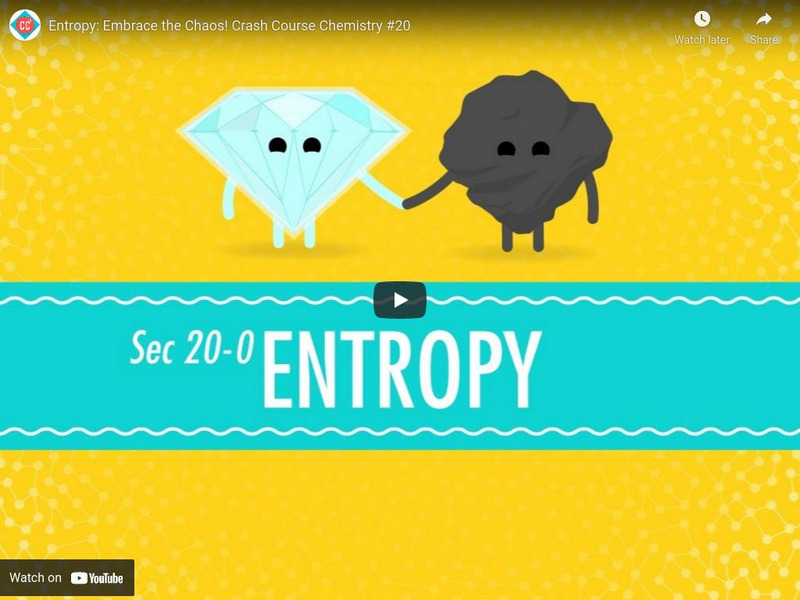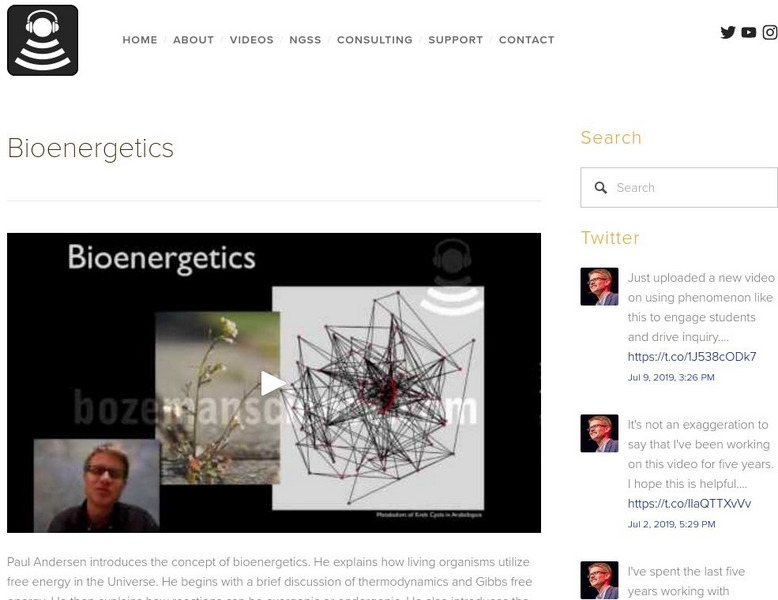Catalyst University
Thermodynamic Parameters of Solution Mixing
Thermodynamic Parameters of Solution Mixing
Catalyst University
Partial Derivatives: Total Differentials
Partial Derivatives: Total Differentials
Bozeman Science
Biology
In this biology video, the instructor introduces the four main concepts behind Biology approved by The College Board—evolution, free energy, information, and systems. Individuals then listen to and see descriptions and examples of each...
Bozeman Science
The Importance of Oxygen
Wow, the human body is complex! The video explores the importance of oxygen, beginning with exploring why it is needed in combustion and then moving into an organism's need for oxygen. Learners see how glucose, when combined with oxygen,...
Bozeman Science
Life Requires Free Energy
Free energy, get your free energy here! Learners see that all organisms require free energy, which comes from the sun. The lesson explains the first two laws of thermodynamics and then analyzes metabolism, via glycolysis, on a very...
Bozeman Science
Photosynthesis and Respiration
View how autotrophs and heterotrophs use the energy of the sun to form the energy their cells need, ATP. Learners watch an informative video that details the processes of photosynthesis, learning where it occurs, what...
Bozeman Science
Bioenergetics
Life requires energy, for without it, you will die! Learners watch a video to see how organisms use free energy, gain knowledge about Gibbs free energy, and observe how free energy plays a role in both photosynthesis and cellular...
Crash Course
Entropy: Embrace the Chaos!
Chemistry makes it seem that everything has its place and behaves according to different laws. Not always true! Disorder and chaos can and do happen in chemistry; scientists call this disorder entropy. Learn about entropy and its...
Berkeley University of California
Weak Acid/Base
Want to hear a joke about nitric oxide? NO! A chemistry video features an instructor adding a weak base to a weak acid, adding a weak acid to a weak base, and offers a one question quiz on pH. This is the 10th set of videos in a...
Educreations
Entropy & Free Energy
An understanding of chemical reactions really boils down to two concepts: entropy and enthalpy. Follow along with this instructional video as it explains how these two principles are used to calculate Gibbs free-energy which...
Khan Academy
Khan Academy: Galvanic Cells and Changes in Free Energy
Recognize the relationship between Gibbs free energy, reaction quotient Q, and cell voltage. [12:31]
Khan Academy
Khan Academy: Nernst Equation
Derive a few different forms of the Nernst equation, the relationship between Gibbs free energy and reaction quotient Q. [6:29]
Bozeman Science
Bozeman Science: Free Energy and the Equilibrium Constant
In the following video Paul Andersen explains how thermodynamic and equilibrium reasoning can be related through changes in free energy and the equilibrium constant. When the delta G is negative the reaction shifts to the right or favors...
Crash Course
Crash Course Chemistry #20: Entropy Embrace the Chaos!
In chemistry, entropy is the measure of molecular randomness, or disorder. Listen to this crash course, and embrace the chaos as Hank teaches about entropy. [13:41]
Khan Academy
Khan Academy: Changes in Free Energy and the Reaction Quotient
This video lesson from Khan Academy is intended for students who are taking the AP Chemistry course. The relationship between Gibbs free energy, standard Gibbs free energy, and the reaction quotient Q. Predicting the direction of the...
Bozeman Science
Bozeman Science: Life Requires Free Energy
Paul Andersen describes how free energy is used by organisms to grow, maintain order, and reproduce. A brief discussion of the first and second law of thermodynamics is also included.
Bozeman Science
Bozeman Science: Bioenergetics
Paul Andersen introduces the concept of bioenergetics. He explains how living organisms utilize free energy in the Universe. He begins with a brief discussion of thermodynamics and Gibbs free energy. He then explains how reactions can be...















